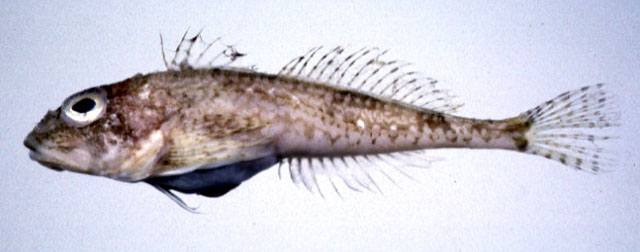| Cottidae (Sculpins) |
| 12.37 cm SL (male/unsexed) |
|
demersal; marine; depth range 48 - 200 m |
| Northwest Pacific. |
|
Dorsal spines (total): 8-9; Dorsal soft rays (total): 18-19; Anal spines: 0-0; Anal soft rays: 14-15. Body elongated, slightly compressed. Head large, compressed. Eyes and mouth large. Parietal spines usually absent. Nuchal spines short, sharp, posteriorly or dorsally directed. Generally body shape and head more slender than other Icelus. Lateral line scales extending past posterior edge of hypural plate, one lateral line scale on caudal fin. A pair of caudal peduncle scales present. Reticulate white vermiculate lines on lateral body surface. Small scales bearing a minute prickle scattered sparsely on dorsal surface of the head. Pectoral fin rounded, reaching to above 1st anal ray; no soft rays branched. Pelvic fin slender, not reaching 1st anal ray. Anal rays unbranched. Each fin membrane thin, easily torn (Ref. 27737). |
| Specimens were collected from sandy-muddy bottoms (Ref. 27737). Minimum depth reported at 200 m (Ref. 27737). |
|
Not Evaluated (N.E.) Ref. (130435)
|
| harmless |
Source and more info: www.fishbase.org. For personal, classroom, and other internal use only. Not for publication.

